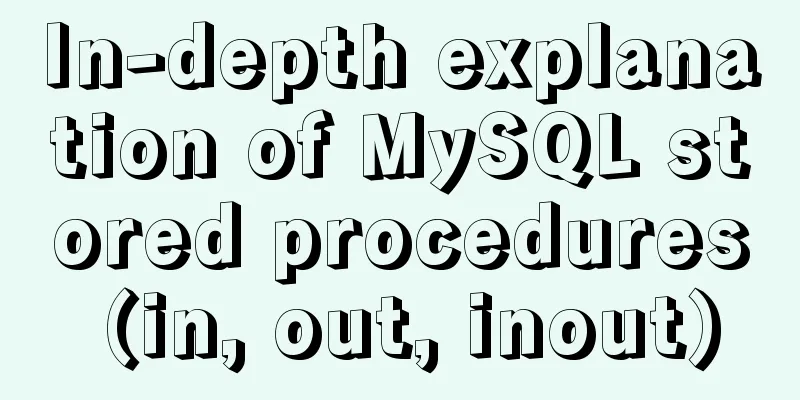Three strategies for rewriting MySQL query statements

|
When optimizing problematic queries, we need to change the way we get query results—but this doesn’t mean getting the same result set from MySQL. Sometimes we can transform a query into a form that gets the same results but with better performance. However, we also need to consider rewriting queries to obtain different results, because this can improve development efficiency. You can also modify the application code to achieve the same effect. This article will introduce some tips on how to rewrite queries. Complex query and step-by-step queryAn important query design question is whether it is better to decompose a complex query into multiple simpler queries. Traditional database design emphasizes solving a large amount of work with as few queries as possible. In the past, this would have been better. This is because of the higher cost of network communication in the past and the load on the query parser and optimizer. However, this advice does not apply much to MySQL, because MySQL handles establishing and disconnecting connections very efficiently and responds quickly to simple queries. Today's network speeds have also increased significantly compared to before. Depending on the server version, MySQL can run more than 100,000 simple queries per second on a normal machine and complete 2,000 query communications per second on a Gigabit network. Therefore, distributing queries is not as bad as it used to be. Compared to the number of data rows traversed per second, the connection response is still relatively slow. In memory data, this time reaches milliseconds. Of course, using as many queries as possible is still a good choice. However, sometimes we can improve performance by splitting a complex query into several simpler queries. Next we'll show some examples. Using too many queries is a common mistake in programming. For example, some applications execute 10 separate queries to fetch 10 rows of data (using a loop to fetch them one by one), when this could be accomplished with a single query that fetches 10 rows of data. Therefore, this does not advocate splitting queries every time, but it depends on the actual situation. Split query statementAnother approach is to split the query and reassemble it. By splitting large data queries into smaller queries to reduce the number of rows affected each time. Cleaning old data is a classic example. Periodic data cleaning requires removing large amounts of data, which can lock large amounts of data rows for long periods of time. This operation also generates transaction logs, consumes a lot of resources, and can block small queries that should not be interrupted. Splitting the DELETE statements into medium-sized queries can significantly improve performance and reduce the extra latency caused by repeated queries when the queries are repeated. For example, the following delete statement: DELETE FROM messages WHERE created < DATE_SUB(NOW(), INTERVAL 3 MONTH); The pseudo code of the application is as follows:
rows_affected = 0
do {
rows_affected = do_query(
"DELETE FROM messages WHERE created < DATE_SUB(NOW(), INTERVAL 3 MONTH)
LIMIT 10000")
} while rows_affected > 0
Deleting 10,000 rows at a time is a large enough task to make each query efficient. A sufficiently short task will reduce the impact on the server (transactional storage engines benefit from this). It is also a good idea to insert some sleep time in the DELETE statements to spread the load over time and shorten the duration of locks held. Disassembling joint queryMany high-performance applications break down joint queries. You can split the union query into multiple single-table queries and then combine the results in the application. For example: SELECT * FROM tag JOIN tag_post ON tag_post.tag_id=tag.id JOIN post ON tag_post.post_id=post.id WHERE tag.tag='mysql'; This union query can be broken down into the following parts. SELECT * FROM tag WHERE tag='mysql'; SELECT * FROM tag_post WHERE tag_id=1234; SELECT * FROM post WHERE post.id IN (123, 456, 567, 9098, 8904); Note: tag_id=1234 and post.id IN (123, 456, 567, 9098, 8904) are the values obtained based on the results of the previous query. Why do this? At first glance this seems unnecessary - it just increases the number of queries. However, this reconstruction of the query can bring the following advantages:
Finally, we can see that by breaking down the union query, the cache can be more reusable, the multi-server distributed data solution can be simpler, and IN queries can be used in large data tables to replace union queries or multiple repeated queries on the same table. The above are the details of the three strategies for MySQL to rewrite query statements. For more information about MySQL rewriting query statements, please pay attention to other related articles on 123WORDPRESS.COM! You may also be interested in:
|
<<: How to configure Http, Https, WS, and WSS in Nginx
>>: Web design and production test questions and reference answers
Recommend
How to locate MySQL slow queries
Preface I believe that everyone has had experienc...
JavaScript to achieve uniform animation effect
This article example shares the specific code for...
IE8 provides a good experience: Activities
Today I had a sneak peek at IE8 beta 1 (hereafter...
Mysql Sql statement comments
You can add comments to MySQL SQL statements. Her...
MySQL multi-instance installation boot auto-start service configuration process
1.MySQL multiple instances MySQL multi-instance m...
Gogs+Jenkins+Docker automated deployment of .NetCore steps
Table of contents Environmental Description Docke...
Simple CSS text animation effect
Achieve results Implementation Code html <div ...
How to design a responsive web? Advantages and disadvantages of responsive web design
I have been learning about responsive design rece...
js realizes a gradually increasing digital animation
Table of contents background Achieve a similar ef...
Five ways to traverse JavaScript arrays
Table of contents 1. for loop: basic and simple 2...
Use native js to simulate the scrolling effect of live bullet screen
Table of contents 1. Basic principles 2. Specific...
An article to help you understand Js inheritance and prototype chain
Table of contents Inheritance and prototype chain...
English: A link tag will automatically complete href in IE
English: A link tag will automatically complete h...
A brief discussion on browser compatibility issues in JavaScript
Browser compatibility is the most important part ...
Detailed explanation of making shooting games with CocosCreator
Table of contents Scene Setting Game Resources Tu...









